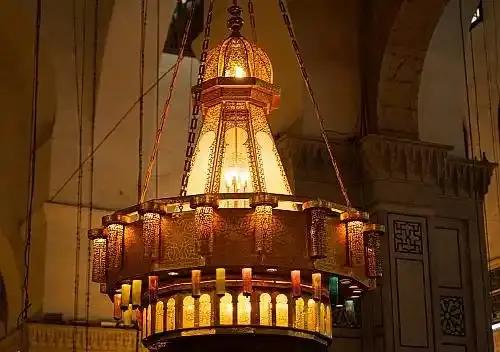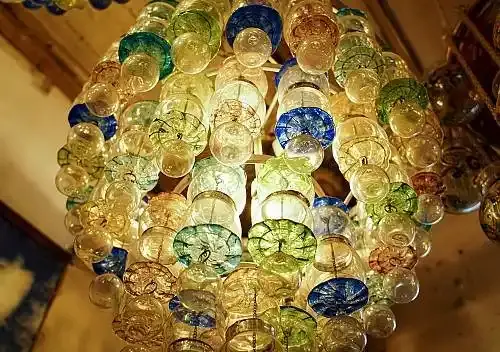Traditional Syrian Glass Blowing : A Timeless Craft
The traditional Syrian glass industry stands as a testament to the country's rich cultural heritage and pivotal role in the history of glassmaking. This ancient craft, characterized by its intricate designs and vibrant colors, has contributed significantly to the development of glassmaking techniques that have influenced civilizations around the world. The story of glassblowing in Syria is a story of innovation, flexibility and artistic excellence, dating back to the early days of human civilization.
1. The origins of the glass industry.

Archaeological excavations have revealed that the glass industry dates back to the third millennium BC. The oldest known glass artefacts were discovered in Mesopotamia and Egypt, suggesting that these regions were pioneers of the art of glass production. In particular, sites such as the ancient city of Tell Brak in modern Syria have shown evidence of early glass manufacturing, including glass beads and small vessels dating back to 2000 BC. These artifacts demonstrate the early mastery of glass as a material, and highlight the importance of the region in the development of glassmaking techniques.
Recommend
One of the most famous early glass artefacts is the glass beaker "Amarna", which dates back to the fourteenth century BC. Found in the ruins of Akhetaten, this Egyptian artifact showcases the advanced glassmaking skills of the time, featuring a vibrant cobalt blue color and intricate patterns. Similarly, the discovery of glass alloys aboard the Uluburun wreck off the coast of Turkey, dating back to the late fourteenth century BC, provides evidence of the flourishing glass trade and technology exchange across the Mediterranean.
2. The role of glass in human development.
Glass has played a crucial role in human development, serving both functional and aesthetic purposes. Glass was initially used to make beads and small decorative elements, and glass soon became an essential material for the manufacture of containers, windows and various household items. Its transparency and versatility have allowed significant advances in science and technology, especially in the fields of optics and chemistry. Thus the development of the glass industry was an integral part of the progress of human civilization.
The invention of the glass mirror in the first century AD by Roman craftsmen revolutionized personal care and interior design. In scientific fields, the development of glass lenses in the Middle Ages led to great advances in astronomy and microscopy, revealing the secrets of the tiny and vast worlds. The role of glass in technology and everyday life cannot be underestimated, as it has been constantly driving innovation and improvement in various aspects of human society. The best proof of this is the spider of fiberglass web,
3. Glass industry in different civilizations and cultures.

Throughout history, different civilizations have contributed to the development of the glass industry. In Egypt, glass was widely used in the production of jewelry and amulets. The Romans, famous for their innovations, mastered the technique of blowing glass, which allowed the production of large quantities of glass elements. In the Islamic world, glassmakers have broken new ground in craftsmanship, producing exquisite lamps, bottles and windows decorated with intricate designs and vibrant colours. Each culture has added its own unique touch, enriching the world heritage of the glass industry.
The Roman period saw the creation of many notable glass artefacts, such as the Portland Vase, a masterpiece of Roman decorative glass dating back to the first century AD. This intricately decorated vessel, now housed in the British Museum, embodies the high level of skill achieved by Roman glassmakers. Similarly, Islamic glassmakers from the eighth to fourteenth centuries produced spectacular works such as the lamps of the Cairo Mosque, which were famous for their beauty and craftsmanship.
4. The beginnings of the glass industry in Syria.

Syria's strategic location and rich cultural exchanges have fostered the growth of the glass industry since 2000 BC. Ugarit became an important center for glass production, as artifacts were discovered there displaying advanced techniques such as pulp forming and mold blowing. Syrian artisans were known for their skill in manipulating glass, producing highly functional and decorative products. The abundance of natural resources, including sand and natroun, has facilitated the growth of this craft.
At Ugarit, archaeologists have discovered a variety of glass items, including glassware and beads, suggesting a sophisticated understanding of glassmaking techniques. The use of pulp forming, where a core is formed from clay or dung and then covered with molten glass, was a common method in this period. In addition, mold-blown glass artefacts, where molten glass is blown into a mold to achieve the desired shape, were also widespread.
5. Syrian contribution to the glass industry.

Syrian glassmakers have made many contributions to the art and science of glass production. One of the most notable innovations was the development of glassblowing tubes, which revolutionized the industry by allowing artisans to create more complex and precise designs. Syrian glass was highly regarded throughout the ancient world for its quality and beauty, often characterized by detailed patterns and vibrant colors obtained through the use of metal oxides. The influence of the Syrian glass industry extended throughout the Roman Empire and beyond, shaping the future of the craft.
The city of Aleppo, in particular, was famous for its glass industry during the Middle Ages. The Aleppo Pine Cone, a glass bowl shaped like a pine cone, is a prime example of innovative designs in the region. Syrian glassmakers also mastered the art of enamel painting, a technique that involves placing stained glass powders on the surface of a glass object and then grilling them to incorporate the enamel into the glass. This method produced beautiful and durable decorations that were in great demand.
6. The golden age of Syrian glass.
The Islamic Golden Age (from the eighth to the fourteenth centuries) was a period of artistic and scientific achievements unparalleled in the Islamic world, including glassmaking. Syrian glassmakers, especially those in Aleppo and Damascus, produced spectacular works that were in great demand. They have mastered techniques such as gilding and enamels, creating stunningly practical and beautiful pieces. This era cemented Syria's reputation as a center of excellence in glass production.
One of the most famous artifacts from this period is the "Glass Lamp of Aleppo", a mosque lamp decorated with enamel and intricate gilding, which served a functional and decorative purpose in religious circles. With their meticulous font and elaborate designs, these lamps are masterpieces of Islamic art. The craftsmanship and artistry displayed in these works highlight the exceptional skills of Syrian glassmakers during this golden age.
7. The decline of the traditional Syrian glass industry and its return.
The decline of the traditional glass industry in Syria began in the late nineteenth century due to industrialization and political turmoil. However, the craft experienced a revival in the late twentieth and early twenty-first centuries as artisans sought to preserve their cultural heritage. Today, efforts to preserve traditional glass blowing include workshops, exhibitions and collaborations with international artists. These initiatives aim to ensure that the old technologies and artistic spirit of the Syrian glass industry continue to flourish.
Institutions such as the "Le Verre de Damas" workshop in Damascus played an important role in this revival. By training a new generation of glassblowers and promoting traditional methods, these efforts have helped revive interest in the Syrian glass industry. In addition, international exhibitions showcased the art of Syrian glass, bringing it to a global audience and highlighting its cultural significance.
Traditional Syrian glass blowing is more than just a craft; it is a symbol of cultural identity and historical continuity. From its early beginnings in Ugarit to its contributions during the Islamic Golden Age, the Syrian glass industry has left an indelible mark on the world. Despite the challenges faced over the centuries, the resilience and creativity of Syrian artisans continues to shine, ensuring that this timeless tradition remains vibrant and relevant to the modern era. By preserving and celebrating this heritage, the legacy of the Syrian glass industry will continue to inspire generations to come.
![]()
Equations That Changed the World of Physics: A Historical View
Equations That Changed the World of Physics: A Historical View more- ADVERTISEMENT
![]()
What is the primary source of oxygen on Earth?
Cyanobacteria were the first to release oxygen through photosynthesis, sparking a massive rise in atmospheric oxygen that wiped out many anaerobic organisms. Today, tiny ocean microbes like Prochlorococcus are major contributors to Earth's oxygen—even more than trees—though most of the planet's oxygen is locked in solid compounds, not the air. more- ADVERTISEMENT
![]()
Elon Musk's Brain Chip - Facts and Oddities
Elon Musk's Neuralink has stirred buzz with its brain chip, Brain-Link, aiming to let humans control devices with their minds. Though still experimental, early tests show promise—like a paralyzed person using it to control a computer—while sparking ethical concerns over privacy, safety, and equality. more- ADVERTISEMENT
![]()
Topkapi Palace ... The largest palaces of Istanbul in Turkey
Topkapi Palace, once home to Ottoman sultans, dazzles with over 12,000 porcelain pieces and secretive chambers. Known as the "Palace of Happiness," it’s now a UNESCO World Heritage Site and ranks among Europe's most visited museums, drawing millions into its rich blend of history, culture, and architectural beauty. more- ADVERTISEMENT
![]()
The world's oceans: species, environments, life and the magic of colors
The oceans, covering over 70% of Earth, are changing color due to climate change and human impact. From deep blue in the Pacific to green or milky turquoise in coastal or Arctic waters, these shifts reveal changes in marine life and health, making ocean conservation more vital than ever. more- ADVERTISEMENT
![]()
Solar panels in the Sahara desert could boost renewable energy but harm global climate
Turning deserts like the Sahara into massive solar farms could power the world and even green the land, but it may also trigger unexpected global climate shifts—like droughts in the Amazon and more hurricanes—making the solution more complex than it seems. more- ADVERTISEMENT
![]()
A Simple Guide to Introducing Yourself: Creating an Unforgettable First Impression
Introducing yourself is more than just saying your name—it’s a chance to show personality, goals, and values. By sharing achievements, teamwork skills, and even hobbies, you can make genuine connections and leave a strong impression, all while staying clear, honest, and adaptable in every interaction. more- ADVERTISEMENT
![]()
How to reduce risk and keep your business stable?
Effective risk management helps protect your business assets, improve decision-making, and avoid costly disruptions. By identifying, assessing, and addressing potential risks, you can ensure smoother operations and even uncover new opportunities. Regular updates, employee involvement, and proper tools can keep your risk strategy strong and your business steady. more- ADVERTISEMENT
![]()
The real signs of a very intelligent person
True Signs of a Highly Intelligent Person more- ADVERTISEMENT
![]()
Cappadocia... The ancient city of caves and mountain chimneys in Turkey
Cappadocia, in central Turkey, is famed for its stunning landscapes, soft volcanic rocks, rock-cut churches, and underground cities. With a history dating back to the third millennium BC, its unique cave dwellings and ancient ruins attract tourists worldwide, especially to places like Goreme, now a UNESCO World Heritage Site. more- ADVERTISEMENT





















